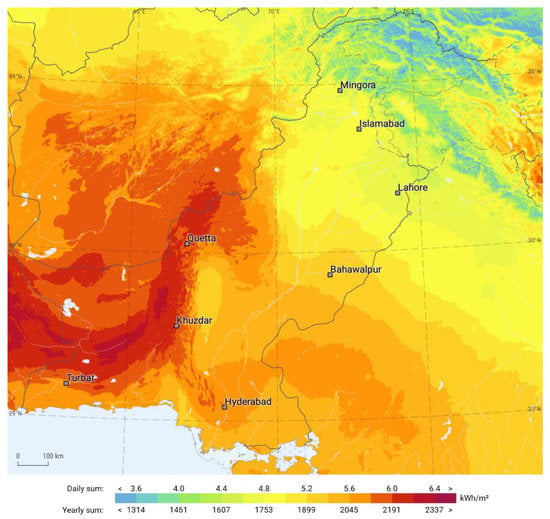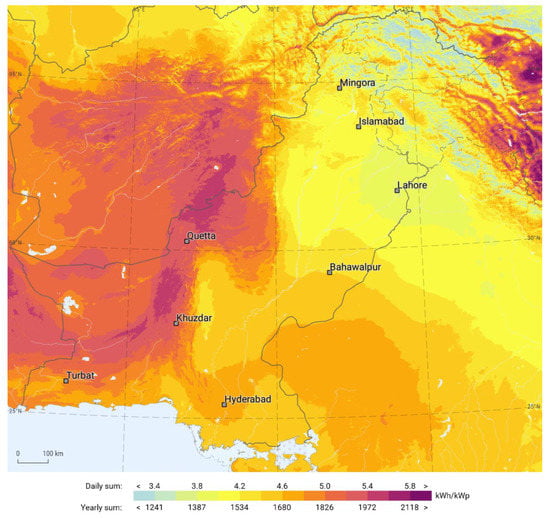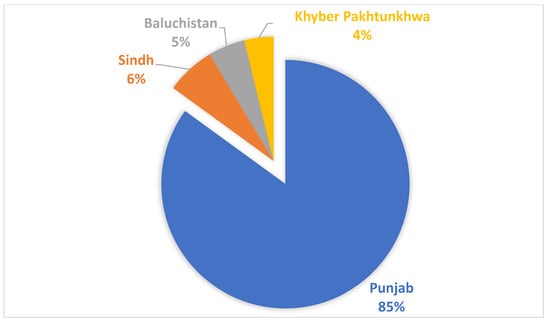You're using an outdated browser. Please upgrade to a modern browser for the best experience.
Please note this is a comparison between Version 1 by Fiaz Hussain and Version 2 by Conner Chen.
Pakistan faces water scarcity and high operational costs for traditional irrigation systems, hindering agricultural productivity. Solar-powered irrigation systems (SPIS) can potentially provide a sustainable and affordable solution, but face technical, financial and policy barriers to adoption.
- solar energy
- solar irrigation
- HEIS
1. Solar Energy Potential in Pakistan
The Pakistan boundary covers an area of 796,096 km2 with latitudes 23°35′ to 37°05′ N and longitudes 60°50′ to 77°50′ E. The areal belt is sunny with a high level of insolation (95% coverage), adequate sunshine hours (8 to 8.5 h a day) and 185 to 290 sunny days in a year [1][2][19,20]. The horizontal surface of the boundary receives a mean global irradiance of 200 to 250 W/d, resulting in 1500 to 3000 sunshine hours per year depending on different locations [3][21]. According to an estimate, this amount provides sufficient electricity to more than 40,000 villages [2][20]. Pakistan has potential for 2.9 million MW of solar energy [4][22].
Global horizontal irradiance is a good resource measurement for solar photovoltaic (PV) installations. The Renewable Energy Resource Mapping program is the initiative of the World Bank and is financed by the Energy Sector Management Assistance Program (ESMAP), providing information on solar resources and the PV power potential of Pakistan with the help of Solargis [5][23]. The detailed data indicated that Pakistan has a PV power potential of 1200 kWh/kWp to 2100 kWh/kWp per year harnessed from the yearly sum of global horizontal irradiation (1300 to 2300 kWh/m2) throughout Pakistan, as shown in Figure 1 and Figure 2. Pakistan has better solar irradiation in the southern and southwestern parts than the north, and the solar potential (especially in the Sindh and Baluchistan provinces) is the second highest in the world [6][24].

Figure 1.
The daily and yearly sum of global horizontal irradiation (kWh/m

Figure 2. The photovoltaic power potential of Pakistan for an open-space fixed-mounted PV system [7].
Pakistan has significant potential for solar energy due to its high solar radiation and large land area. According to the National Renewable Energy Laboratory (NREL), Pakistan has a solar energy potential of approximately 5500 TWh/year, which is equivalent to more than five times the country’s current electricity consumption. A study [8][26] found that Pakistan’s solar energy potential is particularly high in the southern and western regions of the country, where solar radiation levels are among the highest in the world. The study estimates that these regions have the potential to generate more than 20,000 GW of electricity from solar energy. Another study [9][27] found that Pakistan has high potential for solar energy in both on-grid and off-grid applications. The study estimates that the country has the potential to generate more than 10,000 GW of electricity from solar energy, which is equivalent to more than 50% of Pakistan’s current electricity consumption. The study also found that solar energy can provide a reliable source of electricity for remote and off-grid areas, which can help to improve access to electricity in these areas. However, to fully realize the potential of solar energy in Pakistan, several challenges need to be addressed.
According to the World Bank, Pakistan’s current electricity demand can be fulfilled by utilizing only 0.071% of its area for solar photovoltaic energy [10][28] because the average annual solar insolation potential is 5.30 kWh/m2, which can produce 175,800 GW of solar energy [11][29]. The solar market in Pakistan is still at an early stage, but there is significant potential for fulfilling the country’s energy requirements through solar resources [12][30]. Many efforts have been made to set up and increase solar energy penetration in agriculture, as well as domestic and industrial uses in Pakistan [2][20]. Under a development program initiated by the International Renewable Energy Agency in collaboration with China and private-sector energy companies in Pakistan, solar power plants are currently being developed in Punjab, Sindh, Balochistan and Kashmir. In addition, the Quaid-e-Azam Solar Park, which is Pakistan’s first photovoltaic power station with a capacity of 1000 MW, has been completed in Bahawalpur.
2. Solar Irrigation in Pakistan
Pakistan has a total surface water potential of 145 million acre-feet (MAF) and a groundwater potential of 60 MAF, from both, 97% is used for agriculture, where 60% of this is directly or indirectly fulfilled by groundwater [13][31]. Approximately, there are 1.3 million tube wells (the distribution of tube wells in provinces and growth rates are shown in Figure 3 and Figure 4) of which 83% are diesel-powered operated while the growth of electricity tube wells has slowed down due to a rise in the electricity tariff and power outages. Solar pumping technology has emerged as a viable alternative to traditional diesel and electric pumps in recent times. All provincial governments have either planned or implemented subsidized solar irrigation pump schemes, often coupled with High-Efficiency Irrigation Systems (HEIS). While solar irrigation pumps (SIPs) hold great promise in replacing diesel pumps, there are several reasons for the slow adoption rate of this technology. For instance, farmers are not yet willing to shift from flood irrigation to HEIS techniques, and the initial costs of SIPs are high. Additionally, SIPs have lower discharge capacities compared to diesel-powered pumps, and the costs of solar-powered pumping systems significantly rise with an increase in pumping depth and discharge. The government of Punjab, Pakistan, is providing an 80% subsidy on the installation of a HEIS coupled with a solar system. The government of Khyber Pakhtunkhwa has also initiated a 50% subsidy scheme on SIPs in rainfed and water-scarce areas. The Sindh government has launched several solar-powered tube well schemes to strengthen the agriculture sector. In 2017, the federal government and Baluchistan agreed to replace 30,000 grid-connected tube wells with SIPs, but to date, this project has not materialized.

Figure 3.
The percentage share of tube wells, by provinces of Pakistan.

Figure 4.
Growth of tube wells in Pakistan.
Pakistan is an agricultural country facing several challenges such as water scarcity and a lack of efficient irrigation systems. Solar irrigation has the potential to address these challenges and improve agricultural productivity in Pakistan. According to an estimate, solar irrigation can provide irrigation water to about 1.5 million hectares of land in Pakistan [14][4]. Solar energy is abundant, with an average annual solar radiation of 5.5 to 6.5 kWh/m2/day, indicating the significant potential of solar irrigation to improve agricultural productivity and water management in Pakistan as it can provide a reliable and sustainable source of irrigation water for farmers, particularly in remote and off-grid areas [15][32]. Solar irrigation systems were first introduced in Pakistan in the 1980s. However, their widespread adoption and use in the country did not occur until the 2000s. The Pakistan Council of Renewable Energy Technologies (PCRET), established in 1995, has played a key role in the development and promotion of solar irrigation systems in the country. PCRET’s efforts to promote the use of solar energy for irrigation have included the development of low-cost solar irrigation systems, the training of farmers and technicians as well as the conduct of research and development on solar irrigation technology.
Solar irrigation systems can be divided into two main categories: small-scale and large-scale systems. Small-scale systems are designed to meet the irrigation needs of small landholdings and are typically used for horticultural crops and orchards. These systems consist of a small solar panel, a water pump, and a water storage tank. Large-scale systems are designed to meet the irrigation needs of larger landholdings and are typically used for field crops. These systems consist of a larger solar panel, a water pump and a water storage tank. In recent years, the government of Pakistan has also recognized the potential of solar irrigation and has taken steps to promote its use in the country. For example, the government has launched several initiatives to provide subsidies and financial assistance to farmers to purchase and install solar irrigation systems. Additionally, several non-governmental organizations and international development agencies have also been working to promote the use of solar irrigation in Pakistan.
Pakistan lacks a specific policy on SIPs, while various policies are relevant to solar technology for groundwater pumping in agriculture. Water professionals are apprehensive, in that a shift to PV solar pumping may result in uncontrolled pumping and exacerbate groundwater depletion. The number of solar irrigation systems in Pakistan has been growing in recent years, however, the adoption of solar irrigation in the country is still not widespread. The government of Pakistan and other organizations have been working to promote the use of solar irrigation in the country, but more efforts are needed to fully realize the potential of this technology in addressing the water scarcity and irrigation challenges faced by farmers in Pakistan. It is worth mentioning that, as per our knowledge cut-off, there are no specific data available on the exact number of solar irrigation systems installed in Pakistan since 2000. However, it is known that the adoption of solar irrigation in the country has been slow and more efforts are needed to increase the number of systems installed. Factors such as a lack of awareness and knowledge, a lack of access to finance and a lack of technical expertise are some of the barriers that have slowed down the adoption of solar irrigation in Pakistan.
The government of Pakistan is considering an alternate option to switch 1.3 million agriculture tube wells to solar energy to reduce input costs and enhance farm income, particularly that of the small landholders. Under the “free solar pump scheme” the government of Pakistan will provide a free solar pump to low-income families and poor farmers. This, statistically analyzed as the total cultivated area of Pakistan, is 42.6 million acres (MA), of which 13.89 MA is conjunctively irrigated using canal and tube well water. The area irrigated by tube wells is only 6.08 MA, while the estimated coverage is 12 MA. With a rate of 0.5 kW per acre, the solar PV potential is 6000 mega watt (MW). The average horsepower (hp) required per tube well is 17 hp (12.68 kW), while the optimal number of days of operation of solar PV is 300 days per year. For diesel and electric, the number of days of operation is 125 and 184 days per year, respectively. Therefore, the estimated solar PV demand for 300 days of operations is equal to 8400 MW. Assuming a target of 50% conversion in 10 years, the estimated solar PV demand is 4200 MW, while on a yearly basis it is 420 MW (with 110,000+ solar pumps). Converting 50% diesel- and electric-operated pumps to solar can reduce the 4200 MW electricity load that can be put to productive use and reduce the consumption of diesel and fuel import bills. On the other hand, replacing diesel tube wells with SIPs can significantly reduce CO2 emissions. According to an estimate, diesel tube wells contribute approximately 5.025 million metric tons of CO2 emissions per year [16][33]. A greater emphasis on solar power can reduce the cost of electricity generation, lower greenhouse gas emissions and help to address the cost-tariff deficit without the need for tariff hikes that would adversely affect end-users and businesses [17][9]. According to NEPRA’s announcement in January 2019, the average cost of electricity generated from solar PV is approximately 70 USD/MWh [17][9]. Despite being cheaper than thermal and hydropower plants, solar power only contributes 1% to Pakistan’s power generation mix, as depicted in Figure 5. However, solar photovoltaics (PV) are expected to become even more cost-effective in the future, with costs anticipated to significantly decrease [18][34].

